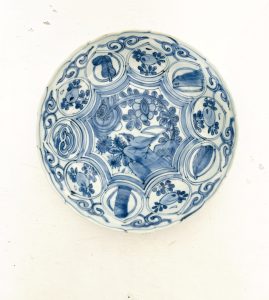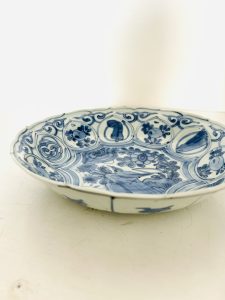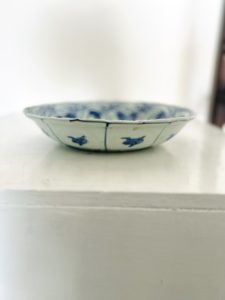たくましさと美しさを併せ持つ芙蓉の花(愛知県名古屋市千種区姫池通 骨董買取 古美術風光舎)
2024.07.13
皆さまこんにちは。スタッフHでございます。
パリオリンピックを2週間後に控え、テレビで過去の五輪競技の映像などを観る機会が多くなりました。
当時の自分を振り返り、時の流れを感じずにはいられません。リオ五輪で日本男子が400mリレーで銀メダルを獲った瞬間は、駅構内のテレビで見ず知らずの人と喜びを分かち合いました。懐かしいです。
さて本日は中国製の「古染付 芙蓉手」をご紹介します。

といいましても知識不足ですので自分なりに調べてみました。
古染付は中国明時代の末期を中心に景徳鎮民窯で焼かれた染付磁器です。形も絵も自由奔放でのびやかさがあり、白く美しい磁器に澄んだコバルトで染付された作品が日本人にも好まれ、日本の茶人からの注文によって作られたものもあると考えられています。
絵柄には長寿、富貴栄華、子孫繁栄などの願いが込められたものが多く描かれています。
その中でも芙蓉手とは見込中央に大きく円窓を施し、周囲を花弁のように区切る文様構成が芙蓉の花を思わせることから名付けられたそうです。17世紀初めにオランダ東インド会社が「染付芙蓉手」の器を中国に特別に注文し輸入したところ、その藍色のみの華やかさがヨーロッパで人気となったとのこと。
その後、明から清への王朝交代に伴う動乱期に中国磁器の輸出は縮小されることとなり、代わりに日本の伊万里焼が芙蓉手を制作し、主に輸出向けの様式としてヨーロッパに渡ることとなりました。
風光舎にございます芙蓉手の皿、手に取るとまずその薄さと軽さに驚きます。お皿の口縁部にかすかに切込みが入っていて花びらの繊細さと軽やかさを演出しています。
淡い藍色の染付で優しい雰囲気なのですが、見込みに描かれた花鳥や縁の吉祥文様が一面にのびやかに描かれていて芙蓉手の名前にふさわしい華やかさがあります。
ところで、今さらですが芙蓉の花とは?
芙蓉はハイビスカスの仲間でもあり、7月から10月にかけて10センチほどの大輪の花が咲く花木だそうですが、花自体は朝に開花し夕方にはしぼんでしまう一日花だそうです。ただ次々と新しい花を咲かせ続けるため長く楽しむことができます。
古代中国では詩や絵画に頻繁に登場し、皇室の庭園に植えられることも多く、美しさと優雅さの象徴とされてきました。
日本においても庭園や茶室の装飾として愛され、夏目漱石や与謝野鉄幹なども歌に詠んでいます。能や狂言といった伝統的な日本芸術にも影響を与え、また富士山もその姿の神秘的で美しい姿から「芙蓉峰」とも呼ばれていたことから日本人には馴染みの深い花だったのでしょう。
芙蓉の一種で10月頃に咲く「酔芙蓉」は、朝に咲いた白い花が夕方にかけて徐々にピンクに色づいていくそうで、その様子が酔っているように見えることから酔芙蓉と名付けられてそうです。なかなか一日眺めていることはできませんが、興味津々です。ぜひお目にかかりたいものです。
個人的にはあまり馴染がなかった芙蓉ですが、この夏、目を凝らして探してみようと思います。
芙蓉は盛夏の暑さにも強く、太陽の光があればアスファルトやコンクリートからでも芽を出し、排気ガスなどの影響をものともせず花を咲かせるそうで、高速道路の街路樹にも使われているそうです。私の勝手なイメージとは違いとてもたくましい花でした。あやかりたいです。
それでは、また次の機会に。


Hello everyone. This is Staff H.
With the Paris Olympics coming up in two weeks, I have had many opportunities to watch the past Olympic games on TV.
Looking back on those days, I can’t help but feel the passage of time. The moment Japan’s men won the silver medal in the 400m relay at the Rio Olympics, I shared my joy with total strangers on the TV in the station. It was nostalgic.
Today, I would like to introduce a Chinese-made “Kozuke (old dyed blue) Fuyote”.
I don’t know much about it, so I did some research on my own.
Ko-zome porcelain was produced in Jingdezhen private kilns mainly in the late Ming Dynasty of China. The shapes and pictures were free and unrestrained, and the beautiful white porcelain, dyed in clear cobalt, was favored by the Japanese, and it is thought that some of the pieces were made to order by Japanese tea masters.
Many of the designs depict wishes for longevity, wealth, prosperity, and offspringhood.
The Dutch East India Company specially ordered and imported hibiscuses from China at the beginning of the 17th century, and their gorgeous indigo color only became popular in Europe. The indigo color of this gorgeous ware became popular in Europe.
Later, during the upheaval that accompanied the change of dynasties from Ming to Qing, exports of Chinese porcelain were curtailed, and instead, Japanese Imari ware produced Fuyo-te porcelain, which was mainly exported to Europe.
The Fuyou-te plate at Fuhkosha is surprisingly thin and light in weight when you pick it up. The faint incision at the mouth edge of the dish allows you to feel the delicacy and lightness of the petals.
The pale indigo-colored underglaze blue gives the dish a gentle atmosphere, but the flowers, birds, and auspicious motifs on the edge of the plate are all painted on the surface, giving it a gorgeous appearance befitting its name “Fuyote.
By the way, what are hibiscuses?
It is said that hibiscus rosebay is also a member of the hibiscus family and is a flowering tree with large flowers of about 10 cm in length from July to October. However, it can be enjoyed for a long time because it keeps producing new flowers one after another.
In ancient China, it frequently appeared in poems and paintings, and was often planted in imperial gardens as a symbol of beauty and elegance.
In Japan, it is also loved as a decorative element in gardens and tea rooms, and has been written about by poets such as Soseki Natsume and Tekkan Yosano. Fuji was also called “Fuyo-bo” (Mt. Fuji) because of its mysterious and beautiful appearance, so the flower must have been familiar to Japanese people.
The “drunken hibiscuses,” a type of hibiscuses that blooms around October, are named “drunken hibiscuses” because their white flowers bloom in the morning and gradually turn pink in the evening, making them look as if they are drunk. It is not easy to spend a whole day looking at them, but I am very interested in them. I would love to see it.
I was not familiar with hibiscuses, but I will try to look for them this summer.
I heard that hibiscuses are used as roadside trees along expressways because they are resistant to the heat of mid-summer, sprout from asphalt or concrete if there is sunlight, and bloom without being affected by exhaust gas. Unlike my own image, it was a very strong flower. I would like to be blessed by them.
See you next time.
*******************
ご実家の整理やお片付けなどをされている方のご相談などが多くございます。
お片付けなどくれぐれもご無理のないようになさってくださいませ。
風光舎では古美術品や骨董品の他にも絵画や宝石、趣味のお品など様々なジャンルのものを買受しております。
お片付けをされていて、こういうものでもいいのかしらと迷われているものでも、どうぞお気軽にご相談下さいませ。
また風光舎は、出張買取も強化しております。ご近所はもちろん、愛知県内、岐阜県、三重県その他の県へも出張いたします。
まずは、お電話お待ちしております。
愛知県名古屋市千種区姫池通
骨董 買取【古美術 風光舎 名古屋店】
TEL052(734)8444
10:00-18:00 OPEN

